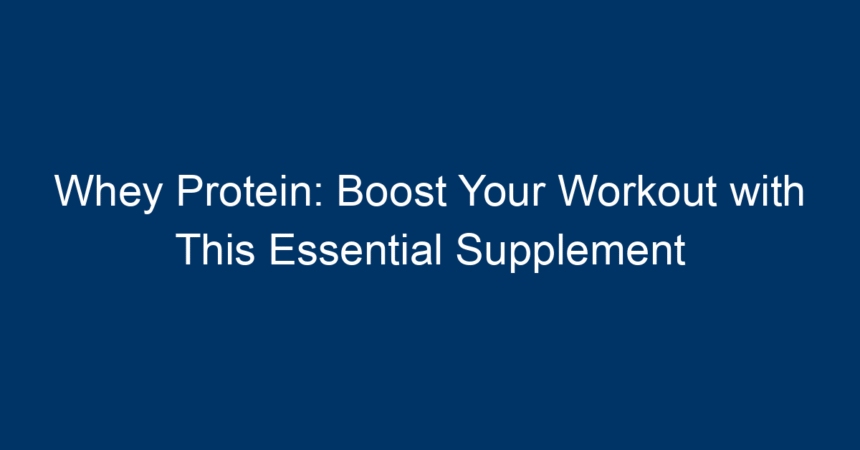In the realm of fitness and nutrition, whey protein stands out as one of the most sought-after supplements. Whether you’re a seasoned athlete or just starting your fitness journey, incorporating whey protein into your diet can significantly enhance your workout regimen. But what exactly is whey protein, and how can it benefit you? In this comprehensive article, we’ll explore the science behind whey protein, its various types, benefits, and tips on how to maximize its potential in your fitness routine.
What is Whey Protein?
Whey protein is a high-quality protein derived from milk. During the cheese-making process, whey is separated from the curds. This process creates a protein-rich liquid that is then processed and dried into a powder form. Whey protein is known for its complete amino acid profile, making it a favorite among athletes and bodybuilders. It’s not just a supplement; it’s a vital piece of the nutrition puzzle that plays a critical role in muscle recovery and growth.
Types of Whey Protein
Understanding the different types of whey protein on the market is key to making the right choice for your needs:
-
Whey Protein Concentrate (WPC): Contains 70-80% protein, along with some fats and carbohydrates. It’s a popular option due to its rich flavor and nutrient profile.
-
Whey Protein Isolate (WPI): Contains 90% or more protein and has most of the fat and carbohydrates removed. Ideal for those who are lactose intolerant or want a purer protein source.
- Whey Protein Hydrolysate (WPH): Pre-digested for faster absorption, this type is often used in medical protein supplements and infant formulas. It can be more expensive but is exceptionally efficient for muscle recovery.
Each type serves a specific purpose, and understanding these differences allows you to tailor your supplementation to meet specific fitness goals.
Benefits of Whey Protein
Incorporating whey protein into your diet offers a plethora of benefits that go beyond muscle building. Here are some of the most significant advantages:
1. Enhanced Muscle Growth
One of the primary reasons individuals turn to whey protein is its effectiveness in promoting muscle growth. The high-leucine content of whey protein stimulates muscle protein synthesis, essential for muscle repair and growth, especially after intense workouts.
2. Accelerated Recovery
Post-workout recovery is crucial for athletes and fitness enthusiasts. Whey protein is quickly absorbed by the body, making it an ideal choice for post-exercise nutrition. Consuming whey protein after a workout can minimize muscle soreness and speed up recovery, enabling you to hit the gym harder next time.
3. Weight Management
Whey protein can be a valuable ally in weight management. High protein intake has been linked to increased satiety, helping you feel fuller for longer. By incorporating whey protein into your diet, you may naturally reduce your calorie intake, facilitating weight loss or maintenance.
4. Immune System Support
Whey protein is rich in immunoglobulins and lactoferrin, which can enhance your immune response. A robust immune system is vital for anyone working out regularly, as intense training can sometimes weaken your defenses.
5. Easy Digestibility
Unlike other protein sources, whey protein is easily digestible and rapidly absorbed. This makes it an excellent protein choice for those who may struggle with digesting other forms of protein or for those looking for a quick post-workout nutrition boost.
How to Incorporate Whey Protein into Your Diet
Maximizing the benefits of whey protein requires strategic planning. Here’s how to seamlessly incorporate this supplement into your daily routine:
1. Pre-Workout Fuel
Consider taking whey protein before your workout. It can provide your muscles with the necessary amino acids to enhance performance.
2. Post-Workout Recovery
The post-workout window is one of the most critical times to consume whey protein. Mixing whey protein powder with water, milk, or a smoothie can help replenish your energy and kick-start the recovery process.
3. Meal Replacement
Whey protein can be an excellent meal replacement option for busy days. Just combine it with fruits, vegetables, or healthy fats like nut butter in a smoothie for a nutritious meal on-the-go.
4. Baking and Cooking
You can easily integrate whey protein into your favorite recipes. Add it to pancakes, muffins, or protein bars for a protein boost without compromising flavor.
Common Myths About Whey Protein
As with any popular supplement, whey protein is surrounded by various misconceptions. Let’s debunk some of the most common myths:
Myth 1: Whey Protein is Only for Bodybuilders
While bodybuilders may be prominent users, whey protein is beneficial for anyone looking to improve their fitness, whether you’re a weekend warrior, an endurance athlete, or simply focusing on weight management.
Myth 2: Whey Protein Causes Kidney Damage
For individuals with pre-existing kidney conditions, excessive protein intake can exacerbate issues. However, for healthy individuals, moderate whey protein consumption is safe and poses no risk to kidney health.
Myth 3: All Protein Supplements are the Same
Not all protein supplements are created equal. The quality of protein, the presence of added sugars or fillers, and the method of processing can significantly affect the benefits. Always choose high-quality whey protein from reputable brands.
Choosing the Right Whey Protein
When selecting a whey protein supplement, consider the following factors:
1. Ingredient Quality
Opt for products with minimal ingredients and no artificial sweeteners, flavors, or preservatives. Look for whey protein sourced from grass-fed cows when possible.
2. Protein Content
Check the protein content per serving. The higher the protein content and the lower the sugar and carbohydrate content, the better, especially if you’re using it post-workout.
3. Brand Reputation
Choose established brands that undergo third-party testing for quality and purity. Reading customer reviews can also provide insights into product effectiveness.
Conclusion: Take Your Workout to the Next Level with Whey Protein
Incorporating whey protein into your nutrition plan is a powerful way to enhance your workout results. With its myriad benefits—ranging from muscle growth and recovery to weight management and immune support—whey protein serves as an essential tool for anyone looking to elevate their fitness regimen.
To maximize its effectiveness, strategically integrate whey protein into your pre- and post-workout nutrition, explore creative ways to include it in meals, and always select high-quality brands.
Actionable Insights:
- Begin your day with a whey protein smoothie packed with fruits and greens.
- Post-workout, mix whey protein with your favorite plant-based milk for a quick recovery shake.
- Explore recipes for protein-enhanced snacks to satisfy cravings without compromising your nutrition.
By making whey protein a regular part of your dietary routine, you can boost your workouts and achieve your fitness goals more effectively. So go ahead, elevate your fitness journey with this outstanding supplement!




